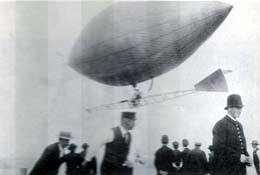On June 27, 1908, L. Guy Mecklem (1882-1973) makes Seattle's first airship ascent at Luna Park on Elliott Bay. A week later he will successfully race automobiles 10 miles to The Meadows racetrack near Georgetown.
Daredevil
Llewellyn Guy Mecklem grew up in Seattle and worked as an itinerant daredevil aeronaut making ascents in tethered hot-air balloons while hanging from a trapeze and then floating to earth under a parachute. He appeared at amusement parks and on behalf of real estate developers. In California he learned to pilot hydrogen-filled airships powered by the aeronaut operating air oars. As a race car driver in Seattle in 1906, he earned the sobriquet "Wild Scotsman."
In the autumn of 1907, Mecklem approached Charles A. Looff, who operated the Luna Park amusement center at Duwamish Head, to stage aerial exhibitions. Looff agreed and Mecklem set out to design a powered airship. From a paper scale model he assembled a silk envelope (with the assistance of two local seamstresses and their sewing machines) in a rented hall in South Seattle. When completed, the envelope measured 58 feet long and 18 feet in diameter at its widest point. A net framework suspended bags of sand and a 38-pound wood frame. A 10-horsepower gasoline engine from the Glenn Curtiss Manufacturing Company of Hammondsport, New York, spun either a two- or four-blade propeller. An automobile clutch allowed the pilot to disengage the propeller from the engine. When packaged for shipment, the whole vehicle weighed less than 500 pounds.
Mecklem moved his airship to a specially constructed hangar at Luna Park at the beginning of the 1908 season. Two 400-gallon wine casks converted sulfuric acid and iron filings to hydrogen gas to inflate the envelope.
On June 27, the airship was ready for its first test flight and a large crowd gathered to witness the event. Mecklem told the men tethering the airship, "Let her go!" and the silk cylinder rose skyward. The aeronaut shifted his weight and used a rudder for control. To go up, he released bags of ballast. To drop, he released gas from the envelope. But June 27 was a sunny day and as the sun heated the envelope, the hydrogen expanded. Before Mecklem could valve gas, the bag ruptured along a bottom seam and the flammable hydrogen spilled upon the hot engine and fiery exhaust. The intrepid aeronaut acted quickly and snatched both sides of the tear while kicking the ignition switch off (The Seattle Sunday Times reported that Mecklem used his teeth). He then retrieved his jackknife and stabbed holes in the bag to release more gas. The crippled airship splashed into Elliott Bay near Queen Anne Hill. Residual gas kept the craft afloat until Mecklem was rescued by the tug Leroy.
The seamstresses stitched the envelope back together in time for a Fourth of July, 10-mile race against automobiles between Luna Park and The Meadows racetrack. Mecklem beat the cars, but almost hit the Duwamish River. He instead landed in a garden next to the track. The cars arrived two minutes later.
Mecklem barged his craft back to Luna Park and made one more flight on July 8. He charged 10 cents each for visitors to examine the airship in its hangar at the park before he took it on the road to fairs in the West. In Compton, California, later that summer, he impaled the airship on a flagpole.
Mecklem tried biplanes, then flew two other airships, and airplanes for two years before leaving aviation and taking up carnival gymnastics, deep-sea diving, and finally berry farming. The former aeronaut died in Bellingham in January 1973. Historian Donald Eklund had asked Mecklem what he called his airship. The old man replied, "I didn't call it anything. Should have named it Mecklem's Follies, I guess. Anyway, it was sure fun chasing those cows" (Eklund, 52).

